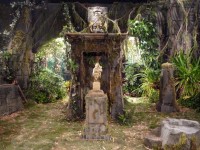When people think of archaeology, their mental image is skewed. They either believe it to be some big, exotic adventure constantly or some kind of trickery. People tend to believe archaeological discoveries are nothing but adventures and proving outrageous legends because most of the “discoveries” that are being spoken of in the news and on the internet are the stories of these means meant for personal gain and not reliable stories that one can trust. These “discoveries” continue to be published because they are what is thought to be interesting and exciting. They are most closely related to what the average person associates with archaeology. The tall tales are what reach the public’s ear because they are fast and easy. People in today’s society do not like to wait for results. To have to wait for an article to pass through the long process of reviews and edits is much too long for the average person’s attention span. A quick Google search is the answer that most people’s hearts desire. When I Googled “current archaeological discoveries”, this was the first website on the list: http://www.archaeologica.org/index.html
This website was a sort of compilation of other sites that can be added by users. There is no way for average people to know if any of these sites have any credibility to them whatsoever. Anyone can contribute and people will take it as truth. Minds are very mold-able.
Perhaps the thing people associate the least with archaeology is sitting at a desk all day long. But, as I discovered, that is a very large part of archaeology. Archaeologists do not just run off to a site and start digging

around. There is a lot of planning and pouring over maps that happens prior to any survey of excavation. I sat at a desk for 3 hours staring at map after map after map comparing the areas surrounding the Ashokan Reservoir and seeing how the areas have changed over time. A large part of archaeology is understanding how large changes to areas can impact everything that has any sort of relationship to the area. The maps have to be overlaid and surveyed to note changes in towns, like if they move to a new location or if they are no more, and roads, and the like. What is now
underwater needs to be noted as well. After all these notes are made about the areas, you need to look at maps of public access areas and compare them to the topographical maps so you can see what possible sites are readily available for surveying and possible excavation. When you are first getting oriented with the maps, you get completely and utterly confused. However, the confusion aids your work, ultimately. It helps you work harder to try and understand just what it is you are looking at and for. Once you work passed this bewilderment, you get into a flow and can continue the work with slightly more ease. After

plotting all these sites and pouring over these maps, your brain does start to hurt, though. I found that listening to David Bowie and Elton John helps that particular affliction.


